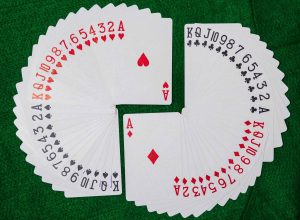There are different types of poker players; you need to know them if you want to win your rounds. Reading this article can help you identify your type and how to deal with them. In addition, you can learn the traits of each type by watching a few different types of poker players. This way, you can know how to play poker accordingly. Here’s a brief description of each, so keep reading!
Loose-Aggressive Player
The main difference between tight and loose-aggressive poker players lies in their tendencies toward making continuation bets on post-flop and turn. On the other hand, loose-aggressive poker players usually break their betting behavior when faced with strong resistance. Therefore, if you want to beat loose-aggressive players, you must develop the art of bluff catching.
While the best loose-aggressive poker players combine passive and aggressive play styles, their tactics and bluffing methods are highly variable. The best loose-aggressive players know which spots tend to be folded more frequently than others. In addition, the study board surfaces to spot auto-profit spots. For example, flops with an ace-high dry are more likely to be folded than a pair of kings, making them prime targets for triple barrel bluffs.
An extreme example of a loose-aggressive poker player is the maniac, who plays almost every hand aggressively. Often, they’re drunk and/or very tilted and blow off steam by spending all their money. They’re very difficult to play against, so you’ll have to adjust accordingly. To become a better player, learn how to adapt to a loose-aggressive player as you will surely come.
Slow-players are the most cunning players. They can read other players and act accordingly, letting other players believe that they have the best hand. Players also know how to play the game and make their opponents believe they’re chasing. They are the worst enemy of the aggressive poker player. You have to adapt your playing style to suit the table. In a tight game, you should not make aggressive moves or get into a hand where you’re afraid to fold.
Tight-aggressive players are difficult to deal with because they tend to play more than 80% of hands. If you’re not ready for that, learn the tight-aggressive style first. After six months of profits, you can move on to loose-aggressive poker. However, it is recommended practice TAG first before trying the loose-aggressive style.
Loose-Passive Player
Loose-passive poker players are stereotypically bad players. They are often too passive and tend to limp in preflop. They also fold post-flop aggressively. Against them, you’ll see them play as if they’re just checking and only raise when they have a strong hand. When you’re up against a loose-passive player, you’ll need to adjust your strategy accordingly.
Loose-passive players limp into a lot of pots, calling preflop raises, check-calling all the way to the river, and folding only with super-strong hands. You’ll need to find premium holdings to beat this type of player. A loose-passive style of play makes it harder to steal blinds. If you’re trying to win a game against a loose-passive player, you need to have premium holdings to beat them.
The calling station is another type of loose-passive player. The calling station has its fingers in many pots and rarely raises. They tend to play their hand to the flop and then raise it when they have a strong hand. While it’s tempting to bluff against this type of player, it’s better to call their bets on the turn and river. However, loose-passive players are difficult to beat online.
Passive-passive poker players often limp in too many pots and call raises when they’re not particularly strong. They rarely show aggression, which is why many beginners use this style of play. Tight-aggressive players, on the other hand, tend to play their best-starting hands and are not afraid to bet aggressively. They are also known as sharks in the poker world. A TAG player is the type of poker player you’re most likely to encounter.
Tight-Aggressive Player
In poker, you can find two types of players – loose and tight-aggressive. Tight-aggressive players are more aggressive than loose players and will bet more when they are on top. They like to put pressure on their opponents. They tend to be effective against passive players but can also be a problem against aggressive players.
Tight-aggressive players often play a narrow range of hands before the flop. This means they don’t fold their hands if they’re behind. However, they’re willing to push through the flop, even if they’re not strong. Then, they’ll be willing to call for a raise from you if you’ve got the upper hand. However, beware – these players are not as aggressive as you might think.
You should take the bull by the horns when you play tight-aggressive poker. That means you should raise if you have a high-quality hand and call down if you’re not. Conversely, you should never fold because your opponents’ top-quality hands are not as good as yours. It’s a dangerous strategy to make mistakes, but it can lead to a win.
A tight-aggressive player should always bet when they think they have a good hand. They should not be making many calls and should only be betting with their strongest hands. However, if they aren’t, they shouldn’t make a lot of calls. They believe they have a strong hand and should bet and are usually very decisive. They’re good at limiting the range of players and are often the most successful players.
Tight-Passive Player
Tight-passive poker players are often not aggressive enough to raise their bets before the flop and prefer to check the flop instead. A tight passive poker player can position themselves well against an aggressive player and increase the value of draws, but he is not always successful. In these situations, he should increase his aggression and force his opponent to fold. However, he should avoid aggressive TP players, who rarely bluff.
Tight passive poker players don’t play many hands and tend to play weakly. A weak-tight player might raise when he or she has the nuts or near-nuts, but this is just a tactic to get out of the way. If he or she does have a good hand, the tight-passive player will bet big before the river to protect their hand and win the pot without confrontation.
Tight-passive players can be vulnerable to aggression, and it is important to recognize this behavior. Tight-passive players usually fold when they do not have a good hand. They may also be vulnerable to bluffs and should only be faced with aggressive opponents who have a solid hand. In general, tight-passive players are the easiest to take on, but the hardest part of beating them is overcoming their tendency to fold.
Tight-passive poker players are easy to exploit. They may play too few hands, but you can exploit them by opening wider and making them uncomfortable. While a tight-passive player may easily win small pots, you can often get out of big pots with aggressive players. They will let you build pots and then fold them if they are weak-tight. Tight-passive players can be very profitable if you’re looking for an easy-to-beat opponent.

Types of Poker Players Conclusion and Summary
If you’re a new online poker player, the types of players you’ll find are a good way to get an idea of their style. While most players are able to identify passive and aggressive players, you can also learn how to spot these poker types with the heads-up display. However, this type isn’t for everyone. The following are the most common types of poker players, so keep researching and start winning your rounds!




